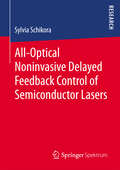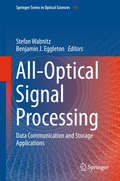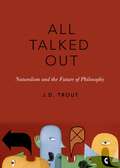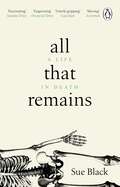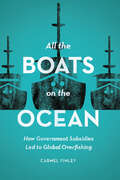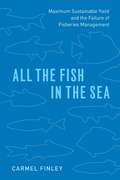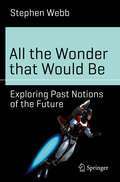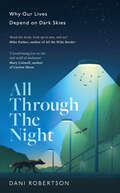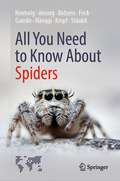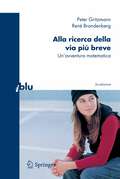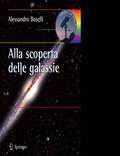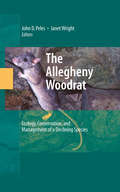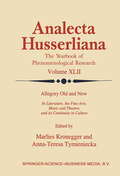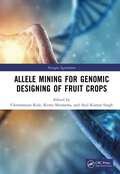- Table View
- List View
All-Optical Noninvasive Delayed Feedback Control of Semiconductor Lasers
by Sylvia SchikoraThe stabilization of unstable states hidden in the dynamics of a system, in particular the control of chaos, received much attention in the last years. In this work, a well-known control method called delayed feedback control is applied for the first time entirely in the all-optical domain. A multisection semiconductor laser receives optical feedback from an external Fabry-Perot interferometer. The control signal is a phase-tunable superposition of the laser signal, and provokes the laser to operate in an otherwise unstable periodic state with a period equal to the time delay. The control is noninvasive, because the reflected signal tends to zero when the target state is reached.
All-Optical Signal Processing: Data Communication and Storage Applications (Springer Series in Optical Sciences #194)
by Stefan Wabnitz Benjamin J. EggletonThis book provides a comprehensive review of the state-of-the art of optical signal processing technologies and devices. It presents breakthrough solutions for enabling a pervasive use of optics in data communication and signal storage applications. It presents presents optical signal processing as solution to overcome the capacity crunch in communication networks. The book content ranges from the development of innovative materials and devices, such as graphene and slow light structures, to the use of nonlinear optics for secure quantum information processing and overcoming the classical Shannon limit on channel capacity and microwave signal processing.Although it holds the promise for a substantial speed improvement, today’s communication infrastructure optics remains largely confined to the signal transport layer, as it lags behind electronics as far as signal processing is concerned. This situation will change in the near future as the tremendous growth of data traffic requires energy efficient and fully transparent all-optical networks. The book is written by leaders in the field.
All Talked Out: Naturalism and the Future of Philosophy (The Romanell Lectures)
by J.D. TroutIn All Talked Out J.D. Trout exemplifies the power of science in a philosopher's hands, and takes a welcome look at the resulting fate of philosophy. Based on his 2013 Phi Beta Kappa Romanell Lectures, each chapter presents a novel and positive view of intellectual advancements with respect to traditional topics in philosophy, and explains why these achievements occurred despite the archaic and often retrograde influence of philosophical doctrine and method. Together, these two lines of inquiry lead the reader to understand that while foundational reflection remains as necessary as ever, philosophy, as it is conceived of in the halls of academia, no longer adds anything distinctively useful. At its best, philosophy is a place to grow new ideas. But many other disciplines can provide such incubation. At the same time, however, we don't have to kill philosophy; but we do have to figure out what is worth preserving. Following a spirited introduction, the first lecture takes stock of the growing field of evidence-based approaches to reasoning, and in light of these scientific developments, criticizes important failures in epistemology as it is currently practiced in the English speaking world. The second lecture examines the psychological impulse to explain, the resulting sense of understanding, and the natural limits of cognitively appreciating the subject we have explained. The final lecture presents the proper reaction to the idea that scientific evidence matters to responsible governance.
All Talked Out: Naturalism and the Future of Philosophy (The Romanell Lectures)
by J.D. TroutIn All Talked Out J.D. Trout exemplifies the power of science in a philosopher's hands, and takes a welcome look at the resulting fate of philosophy. Based on his 2013 Phi Beta Kappa Romanell Lectures, each chapter presents a novel and positive view of intellectual advancements with respect to traditional topics in philosophy, and explains why these achievements occurred despite the archaic and often retrograde influence of philosophical doctrine and method. Together, these two lines of inquiry lead the reader to understand that while foundational reflection remains as necessary as ever, philosophy, as it is conceived of in the halls of academia, no longer adds anything distinctively useful. At its best, philosophy is a place to grow new ideas. But many other disciplines can provide such incubation. At the same time, however, we don't have to kill philosophy; but we do have to figure out what is worth preserving. Following a spirited introduction, the first lecture takes stock of the growing field of evidence-based approaches to reasoning, and in light of these scientific developments, criticizes important failures in epistemology as it is currently practiced in the English speaking world. The second lecture examines the psychological impulse to explain, the resulting sense of understanding, and the natural limits of cognitively appreciating the subject we have explained. The final lecture presents the proper reaction to the idea that scientific evidence matters to responsible governance.
All That Remains: A Life in Death
by Professor Sue Black'Utterly gripping' - The Guardian 'Fascinating' - The Sunday Times 'Moving' - Scotsman 'Engrossing' - Financial Times Sue Black confronts death every day. As a Professor of Anatomy and Forensic Anthropology, she focuses on mortal remains in her lab, at burial sites, at scenes of violence, murder and criminal dismemberment, and when investigating mass fatalities due to war, accident or natural disaster. In All That Remains she reveals the many faces of death she has come to know, using key cases to explore how forensic science has developed, and examining what her life and work has taught her. Do we expect a book about death to be sad? Macabre? Sue's book is neither. There is tragedy, but there is also humour in stories as gripping as the best crime novel. Part memoir, part science, part meditation on death, her book is compassionate, surprisingly funny, and it will make you think about death in a new light. ________ SUE BLACK'S NEW BOOK, WRITTEN IN BONE, IS OUT NOW _________ 'One might expect [this book] to be a grim read but it absolutely isn't. I found it invigorating!' (Andrew Marr, BBC Radio 4 'Start the Week') 'Black's utterly gripping account of her life and career as a professor of anatomy and forensic anthropology manages to be surprisingly life-affirming. As she herself says, it is "as much about life as about death"' (PD Smith Guardian) 'An engrossing memoir . . . an affecting mix of personal and professional' (Erica Wagner, Financial Times) 'A model of how to write about the effect of human evil without losing either objectivity or sensitivity . . . Heartening and anything but morbid . . . Leaves you thinking about what kind of human qualities you value, what kinds of people you actually want to be with' (Rowan Williams, New Statesman) 'For someone whose job is identifying corpses, Sue Black is a cheerful soul . . . All That Remains feels like every episode of 'Silent Witness', pre-fictionalised. Except, you know, really good' (Helen Rumbelow, The Times)
All the Boats on the Ocean: How Government Subsidies Led to Global Overfishing
by Carmel FinleyMost current fishing practices are neither economically nor biologically sustainable. Every year, the world spends $80 billion buying fish that cost $105 billion to catch, even as heavy fishing places growing pressure on stocks that are already struggling with warmer, more acidic oceans. How have we developed an industry that is so wasteful, and why has it been so difficult to alter the trajectory toward species extinction? In this transnational, interdisciplinary history, Carmel Finley answers these questions and more as she explores how government subsidies propelled the expansion of fishing from a coastal, in-shore activity into a global industry. While nation states struggling for ocean supremacy have long used fishing as an imperial strategy, the Cold War brought a new emphasis: fishing became a means for nations to make distinct territorial claims. A network of trade policies and tariffs allowed cod from Iceland and tuna canned in Japan into the American market, destabilizing fisheries in New England and Southern California. With the subsequent establishment of tuna canneries in American Samoa and Puerto Rico, Japanese and American tuna boats moved from the Pacific into the Atlantic and Indian Oceans after bluefin. At the same time, government subsidies in nations such as Spain and the Soviet Union fueled fishery expansion on an industrial scale, with the Soviet fleet utterly depleting the stock of rosefish (or Pacific ocean perch) and other groundfish from British Columbia to California. This massive global explosion in fishing power led nations to expand their territorial limits in the 1970s, forever changing the seas. Looking across politics, economics, and biology, All the Boats on the Ocean casts a wide net to reveal how the subsidy-driven expansion of fisheries in the Pacific during the Cold War led to the growth of fisheries science and the creation of international fisheries management. Nevertheless, the seas are far from calm: in a world where this technologically advanced industry has enabled nations to colonize the oceans, fish literally have no place left to hide, and the future of the seas and their fish stocks is uncertain.
All the Boats on the Ocean: How Government Subsidies Led to Global Overfishing
by Carmel FinleyMost current fishing practices are neither economically nor biologically sustainable. Every year, the world spends $80 billion buying fish that cost $105 billion to catch, even as heavy fishing places growing pressure on stocks that are already struggling with warmer, more acidic oceans. How have we developed an industry that is so wasteful, and why has it been so difficult to alter the trajectory toward species extinction? In this transnational, interdisciplinary history, Carmel Finley answers these questions and more as she explores how government subsidies propelled the expansion of fishing from a coastal, in-shore activity into a global industry. While nation states struggling for ocean supremacy have long used fishing as an imperial strategy, the Cold War brought a new emphasis: fishing became a means for nations to make distinct territorial claims. A network of trade policies and tariffs allowed cod from Iceland and tuna canned in Japan into the American market, destabilizing fisheries in New England and Southern California. With the subsequent establishment of tuna canneries in American Samoa and Puerto Rico, Japanese and American tuna boats moved from the Pacific into the Atlantic and Indian Oceans after bluefin. At the same time, government subsidies in nations such as Spain and the Soviet Union fueled fishery expansion on an industrial scale, with the Soviet fleet utterly depleting the stock of rosefish (or Pacific ocean perch) and other groundfish from British Columbia to California. This massive global explosion in fishing power led nations to expand their territorial limits in the 1970s, forever changing the seas. Looking across politics, economics, and biology, All the Boats on the Ocean casts a wide net to reveal how the subsidy-driven expansion of fisheries in the Pacific during the Cold War led to the growth of fisheries science and the creation of international fisheries management. Nevertheless, the seas are far from calm: in a world where this technologically advanced industry has enabled nations to colonize the oceans, fish literally have no place left to hide, and the future of the seas and their fish stocks is uncertain.
All the Boats on the Ocean: How Government Subsidies Led to Global Overfishing
by Carmel FinleyMost current fishing practices are neither economically nor biologically sustainable. Every year, the world spends $80 billion buying fish that cost $105 billion to catch, even as heavy fishing places growing pressure on stocks that are already struggling with warmer, more acidic oceans. How have we developed an industry that is so wasteful, and why has it been so difficult to alter the trajectory toward species extinction? In this transnational, interdisciplinary history, Carmel Finley answers these questions and more as she explores how government subsidies propelled the expansion of fishing from a coastal, in-shore activity into a global industry. While nation states struggling for ocean supremacy have long used fishing as an imperial strategy, the Cold War brought a new emphasis: fishing became a means for nations to make distinct territorial claims. A network of trade policies and tariffs allowed cod from Iceland and tuna canned in Japan into the American market, destabilizing fisheries in New England and Southern California. With the subsequent establishment of tuna canneries in American Samoa and Puerto Rico, Japanese and American tuna boats moved from the Pacific into the Atlantic and Indian Oceans after bluefin. At the same time, government subsidies in nations such as Spain and the Soviet Union fueled fishery expansion on an industrial scale, with the Soviet fleet utterly depleting the stock of rosefish (or Pacific ocean perch) and other groundfish from British Columbia to California. This massive global explosion in fishing power led nations to expand their territorial limits in the 1970s, forever changing the seas. Looking across politics, economics, and biology, All the Boats on the Ocean casts a wide net to reveal how the subsidy-driven expansion of fisheries in the Pacific during the Cold War led to the growth of fisheries science and the creation of international fisheries management. Nevertheless, the seas are far from calm: in a world where this technologically advanced industry has enabled nations to colonize the oceans, fish literally have no place left to hide, and the future of the seas and their fish stocks is uncertain.
All the Boats on the Ocean: How Government Subsidies Led to Global Overfishing
by Carmel FinleyMost current fishing practices are neither economically nor biologically sustainable. Every year, the world spends $80 billion buying fish that cost $105 billion to catch, even as heavy fishing places growing pressure on stocks that are already struggling with warmer, more acidic oceans. How have we developed an industry that is so wasteful, and why has it been so difficult to alter the trajectory toward species extinction? In this transnational, interdisciplinary history, Carmel Finley answers these questions and more as she explores how government subsidies propelled the expansion of fishing from a coastal, in-shore activity into a global industry. While nation states struggling for ocean supremacy have long used fishing as an imperial strategy, the Cold War brought a new emphasis: fishing became a means for nations to make distinct territorial claims. A network of trade policies and tariffs allowed cod from Iceland and tuna canned in Japan into the American market, destabilizing fisheries in New England and Southern California. With the subsequent establishment of tuna canneries in American Samoa and Puerto Rico, Japanese and American tuna boats moved from the Pacific into the Atlantic and Indian Oceans after bluefin. At the same time, government subsidies in nations such as Spain and the Soviet Union fueled fishery expansion on an industrial scale, with the Soviet fleet utterly depleting the stock of rosefish (or Pacific ocean perch) and other groundfish from British Columbia to California. This massive global explosion in fishing power led nations to expand their territorial limits in the 1970s, forever changing the seas. Looking across politics, economics, and biology, All the Boats on the Ocean casts a wide net to reveal how the subsidy-driven expansion of fisheries in the Pacific during the Cold War led to the growth of fisheries science and the creation of international fisheries management. Nevertheless, the seas are far from calm: in a world where this technologically advanced industry has enabled nations to colonize the oceans, fish literally have no place left to hide, and the future of the seas and their fish stocks is uncertain.
All the Fish in the Sea: Maximum Sustainable Yield and the Failure of Fisheries Management
by Carmel FinleyBetween 1949 and 1955, the State Department pushed for an international fisheries policy grounded in maximum sustainable yield (MSY). The concept is based on a confidence that scientists can predict, theoretically, the largest catch that can be taken from a species’ stock over an indefinite period. And while it was modified in 1996 with passage of the Sustained Fisheries Act, MSY is still at the heart of modern American fisheries management. As fish populations continue to crash, however, it is clear that MSY is itself not sustainable. Indeed, the concept has been widely criticized by scientists for ignoring several key factors in fisheries management and has led to the devastating collapse of many fisheries. Carmel Finley reveals that the fallibility of MSY lies at its very inception—as a tool of government rather than science. The foundational doctrine of MSY emerged at a time when the US government was using science to promote and transfer Western knowledge and technology, and to ensure that American ships and planes would have free passage through the world’s seas and skies. Finley charts the history of US fisheries science using MSY as her focus, and in particular its application to halibut, tuna, and salmon fisheries. Fish populations the world over are threatened, and All the Fish in the Sea helps to sound warnings of the effect of any management policies divested from science itself.
All the Fish in the Sea: Maximum Sustainable Yield and the Failure of Fisheries Management
by Carmel FinleyBetween 1949 and 1955, the State Department pushed for an international fisheries policy grounded in maximum sustainable yield (MSY). The concept is based on a confidence that scientists can predict, theoretically, the largest catch that can be taken from a species’ stock over an indefinite period. And while it was modified in 1996 with passage of the Sustained Fisheries Act, MSY is still at the heart of modern American fisheries management. As fish populations continue to crash, however, it is clear that MSY is itself not sustainable. Indeed, the concept has been widely criticized by scientists for ignoring several key factors in fisheries management and has led to the devastating collapse of many fisheries. Carmel Finley reveals that the fallibility of MSY lies at its very inception—as a tool of government rather than science. The foundational doctrine of MSY emerged at a time when the US government was using science to promote and transfer Western knowledge and technology, and to ensure that American ships and planes would have free passage through the world’s seas and skies. Finley charts the history of US fisheries science using MSY as her focus, and in particular its application to halibut, tuna, and salmon fisheries. Fish populations the world over are threatened, and All the Fish in the Sea helps to sound warnings of the effect of any management policies divested from science itself.
All the Fish in the Sea: Maximum Sustainable Yield and the Failure of Fisheries Management
by Carmel FinleyBetween 1949 and 1955, the State Department pushed for an international fisheries policy grounded in maximum sustainable yield (MSY). The concept is based on a confidence that scientists can predict, theoretically, the largest catch that can be taken from a species’ stock over an indefinite period. And while it was modified in 1996 with passage of the Sustained Fisheries Act, MSY is still at the heart of modern American fisheries management. As fish populations continue to crash, however, it is clear that MSY is itself not sustainable. Indeed, the concept has been widely criticized by scientists for ignoring several key factors in fisheries management and has led to the devastating collapse of many fisheries. Carmel Finley reveals that the fallibility of MSY lies at its very inception—as a tool of government rather than science. The foundational doctrine of MSY emerged at a time when the US government was using science to promote and transfer Western knowledge and technology, and to ensure that American ships and planes would have free passage through the world’s seas and skies. Finley charts the history of US fisheries science using MSY as her focus, and in particular its application to halibut, tuna, and salmon fisheries. Fish populations the world over are threatened, and All the Fish in the Sea helps to sound warnings of the effect of any management policies divested from science itself.
All the Fish in the Sea: Maximum Sustainable Yield and the Failure of Fisheries Management
by Carmel FinleyBetween 1949 and 1955, the State Department pushed for an international fisheries policy grounded in maximum sustainable yield (MSY). The concept is based on a confidence that scientists can predict, theoretically, the largest catch that can be taken from a species’ stock over an indefinite period. And while it was modified in 1996 with passage of the Sustained Fisheries Act, MSY is still at the heart of modern American fisheries management. As fish populations continue to crash, however, it is clear that MSY is itself not sustainable. Indeed, the concept has been widely criticized by scientists for ignoring several key factors in fisheries management and has led to the devastating collapse of many fisheries. Carmel Finley reveals that the fallibility of MSY lies at its very inception—as a tool of government rather than science. The foundational doctrine of MSY emerged at a time when the US government was using science to promote and transfer Western knowledge and technology, and to ensure that American ships and planes would have free passage through the world’s seas and skies. Finley charts the history of US fisheries science using MSY as her focus, and in particular its application to halibut, tuna, and salmon fisheries. Fish populations the world over are threatened, and All the Fish in the Sea helps to sound warnings of the effect of any management policies divested from science itself.
All the Fish in the Sea: Maximum Sustainable Yield and the Failure of Fisheries Management
by Carmel FinleyBetween 1949 and 1955, the State Department pushed for an international fisheries policy grounded in maximum sustainable yield (MSY). The concept is based on a confidence that scientists can predict, theoretically, the largest catch that can be taken from a species’ stock over an indefinite period. And while it was modified in 1996 with passage of the Sustained Fisheries Act, MSY is still at the heart of modern American fisheries management. As fish populations continue to crash, however, it is clear that MSY is itself not sustainable. Indeed, the concept has been widely criticized by scientists for ignoring several key factors in fisheries management and has led to the devastating collapse of many fisheries. Carmel Finley reveals that the fallibility of MSY lies at its very inception—as a tool of government rather than science. The foundational doctrine of MSY emerged at a time when the US government was using science to promote and transfer Western knowledge and technology, and to ensure that American ships and planes would have free passage through the world’s seas and skies. Finley charts the history of US fisheries science using MSY as her focus, and in particular its application to halibut, tuna, and salmon fisheries. Fish populations the world over are threatened, and All the Fish in the Sea helps to sound warnings of the effect of any management policies divested from science itself.
All the Fish in the Sea: Maximum Sustainable Yield and the Failure of Fisheries Management
by Carmel FinleyBetween 1949 and 1955, the State Department pushed for an international fisheries policy grounded in maximum sustainable yield (MSY). The concept is based on a confidence that scientists can predict, theoretically, the largest catch that can be taken from a species’ stock over an indefinite period. And while it was modified in 1996 with passage of the Sustained Fisheries Act, MSY is still at the heart of modern American fisheries management. As fish populations continue to crash, however, it is clear that MSY is itself not sustainable. Indeed, the concept has been widely criticized by scientists for ignoring several key factors in fisheries management and has led to the devastating collapse of many fisheries. Carmel Finley reveals that the fallibility of MSY lies at its very inception—as a tool of government rather than science. The foundational doctrine of MSY emerged at a time when the US government was using science to promote and transfer Western knowledge and technology, and to ensure that American ships and planes would have free passage through the world’s seas and skies. Finley charts the history of US fisheries science using MSY as her focus, and in particular its application to halibut, tuna, and salmon fisheries. Fish populations the world over are threatened, and All the Fish in the Sea helps to sound warnings of the effect of any management policies divested from science itself.
All the Wonder that Would Be: Exploring Past Notions of the Future (Science and Fiction)
by Stephen WebbIt has been argued that science fiction (SF) gives a kind of weather forecast – not the telling of a fortune but rather the rough feeling of what the future might be like. The intention in this book is to consider some of these bygone forecasts made by SF and to use this as a prism through which to view current developments in science and technology.In each of the ten main chapters - dealing in turn with antigravity, space travel, aliens, time travel, the nature of reality, invisibility, robots, means of transportation, augmentation of the human body, and, last but not least, mad scientists - common assumptions once made by the SF community about how the future would turn out are compared with our modern understanding of various scientific phenomena and, in some cases, with the industrial scaling of computational and technological breakthroughs.A further intention is to explain how the predictions and expectations of SF were rooted in the scientific orthodoxy of their day, and use this to explore how our scientific understanding of various topics has developed over time, as well as to demonstrate how the ideas popularized in SF subsequently influenced working scientists. Since gaining a BSc in physics from the University of Bristol and a PhD in theoretical physics from the University of Manchester, Stephen Webb has worked in a variety of universities in the UK. He is a regular contributor to the Yearbook of Astronomy series and has published an undergraduate textbook on distance determination in astronomy and cosmology as well as several popular science books.
All These Worlds Are Yours: The Scientific Search for Alien Life
by Jon WillisLong before space travel was possible, the idea of life beyond Earth transfixed humans. In this fascinating book, astronomer Jon Willis explores the science of astrobiology and the possibility of locating other life in our own galaxy. Describing the most recent discoveries by space exploration missions, including the Kepler space telescope, the Mars Curiosity rover, and the New Horizons probe, Willis asks readers to imagine—and choose among—five scenarios for finding life. He encourages us to wonder whether life might exist within Mars’s subsoil ice. He reveals the vital possibilities on the water-ice moons Europa and Enceladus. He views Saturn’s moon Titan through the lens of our own planet’s ancient past. And, he even looks beyond our solar system, investigating the top candidates for a “second Earth” in a myriad of exoplanets and imagining the case of a radio signal arriving from deep space. Covering the most up-to-date research, this accessibly written book provides readers with the basic knowledge necessary to decide where they would look for alien life.
All Through the Night: Why Our Lives Depend On Dark Skies
by Dani RobertsonBest New Books on Space 2024 – Forbes ‘Rarely is a non-fiction book about science this engaging’ – Forbes
All You Need to Know About Spiders
by Wolfgang Nentwig Jutta Ansorg Angelo Bolzern Holger Frick Anne-Sarah Ganske Ambros Hänggi Christian Kropf Anna StäubliAll You Need to Know About SpidersSpiders are super predators and devour everything they can overpower. To do this, they have developed incredibly good catching techniques and, with spider silk, a tool that makes material technology green with envy. The males are usually smaller than the females and, in order to have sex, they have to come up with a lot to avoid being misunderstood as easy prey: Dancing, drumming, and gifts almost always help. Spiders use their venom in very precise doses, and since humans are not on their menu, they are harmless to us. Many people's (unnecessary) fear of spiders finds cultural roots as early as the Middle Ages. Nevertheless, spider fear is easily treatable. There is no habitat or building without spiders. And that's a good thing, because spiders have fascinating properties and their world is full of surprises. Everything you need to know about them is explained in this book in understandable language by experts for laymen. In addition, some of the most common spider species in the house and garden are briefly presented with tips for observation. The authorsThis book is authored by eight scientists, all of them members of the Association for the Promotion of Spider Research: Wolfgang Nentwig, Jutta Ansorg, Angelo Bolzern, Holger Frick, Anne-Sarah Ganske, Ambros Hänggi, Christin Kropf und Anna Stäubli
Alla ricerca della via più breve: Un'avventura matematica
by Peter Gritzmann Rene BrandenbergIl libro narra la vicenda di Rut, quindicenne, trasferitasi da poco in Germania con la famiglia, al seguito del padre che lavora per un’azienda internazionale produttrice di Software. Sarà proprio il padre a regalare a Rut un computer nuovo, mentre a scuola attraversa un periodo di crisi. E’ l’inizio di un’avventura. Nel computer è installato Vim: un programma che ascolta, capisce e risponde alle domande che la ragazza, inizialmente incredula, fa. Raccontata da Vim, la matematica prende una forma completamente nuova, sorprendente e affascinante. Il lettore è così guidato, con Rut, alla scoperta di quel settore della matematica discreta che affronta, specialmente nell’ambito della teoria dei grafi, l’eterno problema della ricerca della "via maestra", ossia di quel percorso che, tra i tanti possibili, si distingue perché più breve, più economico, più diretto, più veloce o in qualche senso immaginabile.
Alla ricerca della via più breve: Un'avventura matematica (I blu)
by Peter Gritzmann Rene BrandenbergIl libro narra la vicenda di Rut, quindicenne, trasferitasi da poco in Germania con la famiglia, al seguito del padre che lavora per un’azienda internazionale produttrice di Software. Sarà proprio il padre a regalare a Rut un computer nuovo, mentre a scuola attraversa un periodo di crisi. E’ l’inizio di un’avventura. Nel computer è installato Vim: un programma che ascolta, capisce e risponde alle domande che la ragazza, inizialmente incredula, fa. Raccontata da Vim, la matematica prende una forma completamente nuova, sorprendente e affascinante. Il lettore è così guidato, con Rut, alla scoperta di quel settore della matematica discreta che affronta, specialmente nell’ambito della teoria dei grafi, l’eterno problema della ricerca della "via maestra", ossia di quel percorso che, tra i tanti possibili, si distingue perché più breve, più economico, più diretto, più veloce o in qualche senso immaginabile.
Alla scoperta delle galassie (Le Stelle)
by A. BoselliTradotto dall'originale francese "A la decouverte des galaxies", il testo, centrato sullo studio delle galassie, è supportato da numerose fotografie spettacolari ottenute dai più recenti telescopi e satelliti. E' indirizzato a un pubblico assai ampio, che include studenti degli ultimi anni dei licei o dei primi anni delle facolta scientifiche, astronomi amatori o a tutte le persone con qualche competenza scientifica interessate all'astronomia. La descrizione delle immagini e la spiegazione dei processi fisici è infatti fatta in modo semplice, senza l'uso del formalismo matematico, per rendere il testo accessibile a tutti.
The Allegheny Woodrat: Ecology, Conservation, and Management of a Declining Species
by Janet Wright John D. PelesA decline in populations of Allegheny woodrats (Neotoma magister) was first noticed in the 1980s. Since that time, woodrats have become extirpated from at least two states and have declined dramatically in several others. Recent evidence suggests that the decline of this species may be proceeding further south to include states where woodrat populations were previously considered to be stable. The Allegheny Woodrat: Ecology, Conservation, and Management of a Declining Species provides a comprehensive summary of research conducted over the past twenty-five years. The book integrates the results of this research into a comprehensive picture of the ecological requirements, conservation principles, and management strategies for this declining species. In addition, general principles learned from the study of woodrats are applied to the conservation and management of other declining species, including other species of Neotoma. The editors and chapter authors are researchers from both academic settings and state management agencies, individuals who have contributed significantly to the study of Allegheny woodrats during the past two decades. The book will be of interest to ecologists, conservation biologists, wildlife professionals, and students.
Allegory Old and New: In Literature, the Fine Arts, Music and Theatre, and Its Continuity in Culture (Analecta Husserliana #42)
by M. Kronegger Anna-Teresa TymienieckaAllele Mining for Genomic Designing of Fruit Crops (Nextgen Agriculture)
by Chittaranjan Kole Kenta Shirasawa Anil Kumar SinghThis book deliberates on the concept, strategies, tools, and techniques of allele mining in fruit crops and its application potential in genome elucidation and improvement including studying allele evolution, discovery of superior alleles, discerning new haplotypes, assessment of intra- and interspecific similarity, and also studies of gene expression and gene prediction. Available gene pools in global germplasm collections specifically consisting of wild allied species and local landraces for almost all major crops have facilitated allele mining. Advanced genomic techniques have been developed including PCR-based allele priming and Eco-TILLING-based allele mining that are being widely used now for mining superior alleles. Allele discovery has become more relevant now for employing molecular breeding to develop designed crop varieties matching with consumer needs and also with genome plasticity to adapt the climate change scenarios. All these concepts and strategies along with precise success stories are presented over the chapters dedicated to the major fruit crops.The features of this book are as follows: The first book on the novel strategy of allele mining in fruit crops for precise breeding Presents genomic strategies of mining superior alleles underlying agronomic traits from genomic resources Depicts case studies of PCR-based allele priming and Eco-TILLING-based allele mining Elaborates on gene discovery and gene prediction in major fruit crops This book will be useful to students and faculties in various plant science disciplines including genetics, genomics, molecular breeding, agronomy, and bioinformatics; scientists in seed industries; and also policy makers and funding agencies interested in crop improvement.
